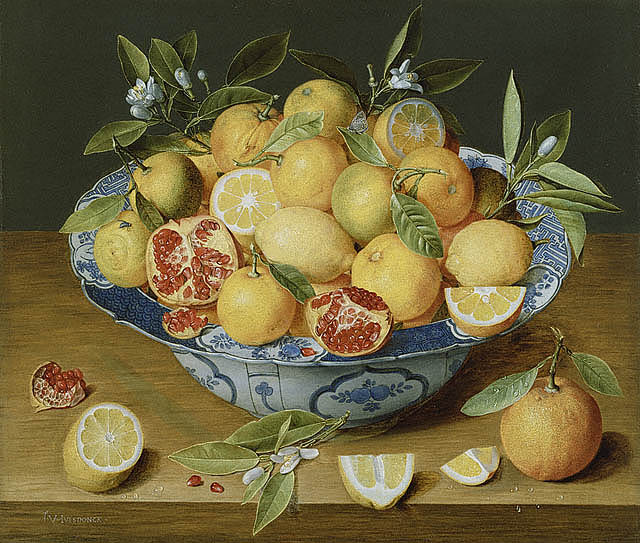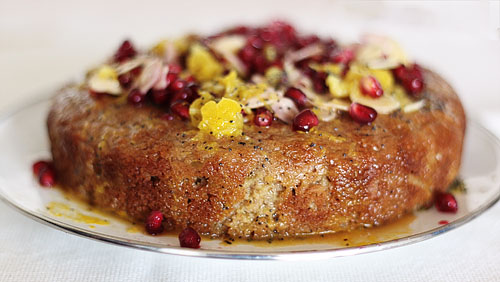Historically, the pomegranate was used to symbolise fertility due to the mythical origins of the fruit. As related by Silvia Malaguzzi in her book Food and Feasting in Art, the god Acdestis, violent and lustful, was “handed over to Bacchus, who got him drunk. Once Acdestis had passed out, Bacchus tied up his feet and genitals. When Acdetis woke up, blood seeping from his genitals formed the pomegranate. The fruit was taken to the nymph Nana, who became pregnant by it and gave birth to Atys” (1). From the outside, the pomegranate is a fairly inauspicious fruit. It was not until I sliced it open, the crimson juice staining the cutting board and splattering on my clothes, that the corporeal aspect of the fruit was revealed. Within the iconography of the Christian Church, the pomegranate represents the blood of Christ. The name is derived from the Latin pōmum meaning apple and grānātus meaning seeded. Beating a section of the fruit with the back of a spoon yields a scattering of round ruby seeds. The pomegranate is sometimes thought to be the forbidden fruit of the Garden of Eden, similar to the ‘garden of paradise’ of Qur’an where the ancient fruit with the jewel-like seeds grew (2).

oil on panel, 42 x 49.5 cm, The Getty Collection
Jacob van Hulsdonck was a native of Antwerp who spent a large portion of his life in Germany where he began his artistic studies. Upon his return to Antwerp at the age of 27, he joined the local painters’ guild. Van Hulsdonck specialised in still life painting, becoming a master through his carefully rendered details. In Still Life with Lemons, Oranges and a Pomegranate (c.1620-40), van Hulsdonck meticulously depicts the rough texture of the citrons. Small droplets of water lay scattered on the table and cling delicately to the leaf of the orange in the bottom right of the panel. According to the Getty Museum, the blue and white porcelain bowl dates from the Wan-Li period of the Ming dynasty (3). Painted from a high vantage point, the majority of the fruit bounty is visible in the bowl, preserving the fleeting life of the natural products.

Orange & Almond Cake with Pomegranates & Poppy Seeds
Adapted from What Katie Ate
Yield: 8 servings
1 1/2 cups almond meal
1/2 cup all-purpose flour
1/2 cup sugar
1 teaspoon baking powder
1/2 tsp cinnamon
3 eggs, separated
juice of 2 oranges + 1 orange, divided
1 teaspoon sugar
seeds from 1/2 pomegranate
1/4 c almond flakes
pinch of poppy seeds
Preheat the oven to 350°F/180°C. Line a 8-inch cake pan with baking paper and set aside. In a large bowl stir together the almond meal, flour, sugar, baking powder and cinnamon. Stir in the egg yolks and orange juice until just mixed, being careful not to overwork the batter.
In a separate bowl, whisk the egg whites until they form stiff peaks. Carefully spoon 1/3 of the egg whites into the cake batter, folding gently to loosen the batter. Scoop the remaining egg whites into the batter and stir until they are just incorporated. Pour into lined baking pan and slide into the oven for 40-50 minutes until the top is golden brown and an inserted toothpick comes out clean. Remove from the oven and lift out of the pan by the baking paper. Peel off the paper and set aside on serving platter.
Meanwhile, de-seed the pomegranate and set aside. Juice the remaining orange into a small saucepan, adding any pulp from within the orange halves. Stir in the sugar and mix until it is dissolved. Simmer over medium-high heat until reduced by half. Scatter the pomegranate seeds over the top of the cake along with the flaked almonds. Add the poppy seeds to the orange juice, swirl to mix and drizzle over the cake, covering the top evenly. Serve warm and keep in an airtight container for up to 4-5 days.


9 comments
Apex@blueapocalypse says:
Mar 17, 2011
I love orange and almond cake but I haven’t thought of including pomegranates before. I imagine that it would taste great, I can’t wait to try it.
Julie says:
Mar 17, 2011
Your cake looks so lovely yet decadent! The pomegranate seeds add rich color and, I am sure, a burst of sunshine.
deana says:
Mar 18, 2011
Gorgeous painting and dessert. I am really surprised about the golden skins of the pomegranates… I didn’t know they were ever that color. I know that tomatoes and potatoes were once golden and purple, so it makes sense there have been changes in time.
PS. Posting for your contest soon!!
Rosa says:
Mar 18, 2011
A luscious cake! That combination is divine.
Cheers,
Rosa
sally says:
Mar 18, 2011
Beautiful! The cake is a perfect match for the painting!
Big Fan says:
Mar 19, 2011
Your cake captured the colors of the painting.
Lael says:
Mar 20, 2011
What a deliciously textured cake! It would be a wonderful meal all in itself, I’m sure. The incorporation of the one pomegranate in van Hulsdonck’s painting really enhances the whole thing. I love the droplet details.
Ellie @ Kitchen Wench says:
Mar 21, 2011
Oooh, orange and poppyseed cake is always a winner as far as I’m concerned! It looks lovely with the almond flakes and pomegranate seeds on top :)
Jessica says:
Mar 22, 2011
Beautiful!